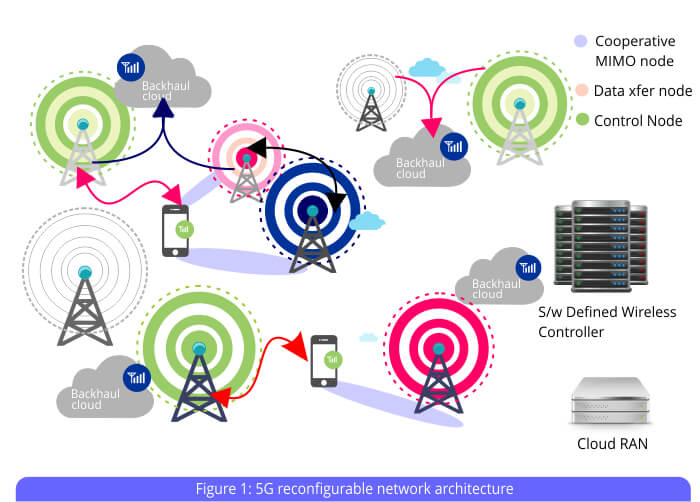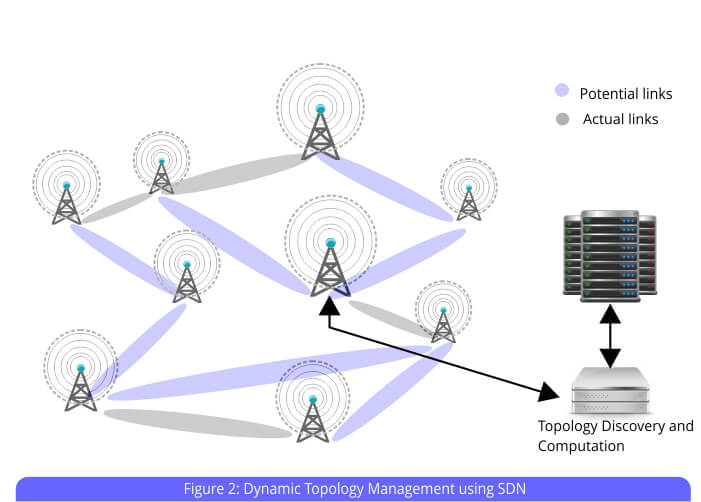Introduction
The case for mmWave in 5G networks is rather strong (Rappaport, Sun, et al. 2013). Given the continuous demand for spectrum and the recent progresses in mmIC fabrication technology, we can reasonably expect to see mmWave migrate from the existing point to point backhaul links to a more dynamic role; fronthaul (the link between the base-band unit (BBU) and the remote-radio heads (RRH) of the newly decoupled cloud RAN (Mugen Peng 2015)) and eventually the access network.
SDN has also been increasingly deployed in terrestrial networks (Nunes, et al. 2014), providing hitherto unprecedented flexibility and significant enhancements in security. The fundamental concept of SDN, the decoupling of the control and packet processing planes have required significant changes in the underlying network architecture, as well as re-engineering of both the control as well as the end-point devices. However, the migration to SDNs is steadily taking place in the terrestrial world.
SDN for the cellular world has also been discussed under the aegis of Cellular SDN (Woon Hau Chin 2015). In (Kostas Pentikousis 2013), the authors propose a modification of SDN OpenFlow for the mobile cellular core network, which they have termed MobileFlow. The key aspect of MobileFlow is the replacement of the SGW and PGW in the current EPC by a combination of controllers (the role already played by the MME today) and forwarding entities, which implement the routing policies commanded by the controller based on UE identity and application. A similar paper has been published by (Rexford 2012)
SDN and Reconfigurable RAN architectures
In this paper, we would like to consider applicability of SDN principles in the RAN; to this end, we need a radio network which can actually support and use SDN principles. We believe that 5G networks, based around c-RAN principles and using reconfigurable mm-wave links for cross-hauling offer just such an opportunity.
mmWave based Cloud RAN
The Cloud RAN paradigm, briefly alluded to above (Mugen Peng 2015), involves a re-engineering of the existing RAN into a combination of radio-heads and base-band processing units. The Remote Radio Heads are modular units which can be used for one of the multiple functions of a BS. Hence, we can designate a certain remote radio head for synchronization signal transmission, another for paging, the rest for unicast data transfer and so on. This a fundamental underpinning of 5G network evolution; the ability for the network to dynamically adapt to the traffic needs. In our own research, we have identified additional RRH functions in inter-node coordination (coordinated massive MIMO), interference cancellation, etc.
The above is possible only if we have a network which can enable communication between the RRHs individually and also from the RRH to the BBU. It is clear that this ëfronthaulí network must support extremely high bandwidths and low latencies; for example, an RRH communication to the cloud RAN (depending on the functionality in the RRH) can require from 155 Mb/s to 3 Gb/s of data transfer bandwidth. It is also clear that this bandwidth is required non-uniformly and the fronthaul network topology must follow that of the radio-network.
(De la Oliva 2015) describe an architecture called Xhaul which is currently being worked upon. The Xhaul architecture supports the kind of 5G RAN that we have described above; in the Xhaul terminology, RRHs, Access Points, etc. are all 5G Points of Attachment (5gPoA). The Xhaul architecture supports multiple high-capacity transmission technologies (copper, mmwave, microwave, fiber, etc.) for point to point communication. The different technologies have a convergence layer which offers a standardized packetization technology (for encapsulating CPRI, for example) and an SDN like control architecture on top of it, to allow quick reconfiguration of the underlying network.
Challenges of SDN for Wireless Networks
Given the inevitable evolution of cellular networks and the touted benefits of SDN, it would seem obvious to merge the two. However, there are some real challenges which are still being worked on.
The first one is the ability to implement fast-packet switching at the end point. We recall from (Nunes, et al. 2014) that SDN works the best when packet switching is spread into the endpoints and control takes placed centrally. RRHs are designed to handle the basics of transceivers at very high rates; A/D and D/A conversion, high bandwidth sampling and assorted signal processing tasks. We are now asking them to take on the additional tasks of high-speed packet switching as well. These are two different functions, typically targetted towards different hardware platforms (DSP for signal processing, dedicated switching cores/NPs for packet processing). We are now talking about merging the two of them into a single hardware platform, retaining the cost advantages in the split BS architecture.
The second one is scalability and density of the network node. Part of the reason for considering dynamic topologies for 5th generation networks is the consideration that mm-wave networks will require significant additional numbers of remote radio-heads (Rappaport, Gutierrez, et al. 2013), with a maximum practical cell-size of 200m. The trade-off is between providing a densely connected network with high energy load for the wireless links or having the capability to extensively reconfigure links and relay data between links.
Integrated Processing and Packet Switching
The problem of integrating packet switching and signal processing in a single hardware platform has recently started getting some attention (Roya Alizadeh 2015), mostly in the context of the cloud, though the same challenges remain in the RRH. The key problems can be summarized as follows:
- Signal processing needs to be extremely deterministic in terms of time taken to complete a particular function. Network I/O processing on the other hand is interrupt driven and can easily cause large variations in time. In general, there are limited options for direct network access i.e. TCP/IP stacks on DSP. Freescaleís OpenDataPlane is an exception.
- Network functions use large amounts of data and consequently uses large amounts of IPC (DMA, shared memory, etc.) to move data in and out of application processing stage to main memory. This can cause emptying of the L1/L2 cache; in the worst case, it can cause a TLB cache flush which takes a very long time to recover. General purpose processors with hardware assisted virtual memory can compensate for this by using pre-allocated application memory in very large page sizes, as is available in most as is done in DPDK. DSPs and similar processors which directly address physical memory cannot use any of these mechanism.
- It might be possible to build a multi-core SoC to split functions, so that signal processing is separated from packet processing. However, there will be a very large inter-core data-sharing required between the two, which once again can interfere with the deterministic nature of the signal processing function.
These problems need to be addressed. Intelís MKL is a set of vectorized libraries used for high speed signal processing on general purpose processor cores. Other solutions used by HSC inhouse include hand-tuned modifications of the GSL (Gnu Scientific Library) for specific functions like QR decomposition for precoding matrix calculation.
Dynamic Network Topology Management
The second problem that we will discuss is the dynamic network topology management. We consider a network consisting of N_p densely arranged network nodes, with each network node potentially able to form links (using sectoral antennae and dynamic beam-forming) with upto N_v of their neighbours. Any network actually formed needs to be evaluated for:
- Connectedness. All nodes should have a path back to the network control center
- End-to-end bandwidth and latency, for each node to each possible neighbour as well as the center.
- Switching capacity for each intermediate node.
It is obvious that an exhaustive search is T(N_p*N_v) which becomes impractical as the network density increases. Even the standard algorithms based on Bellman-Ford and dynamic programming are difficult to implement, because the path weights are not necessarily cleanly additive, as required. Newer algorithms based on distributed bidding techniques, branch and bound methods, etc. have to be utilized for topology discovery. This is an area of active research.
Conclusion
In this paper, we have examined some of the considerations and applications in SDN for mm-wave wireless networks, specifically in the context of 5th generation front-haul. Arguably SDN concepts will go a long way in making dense mm-wave networks a reality. However, there are some technical challenges which have to be overcome to make this a reality. Significant progress has already been made and the main ingredients in making it a part of the 5th generation reality are in place.
Works Cited
De la Oliva, Antonio and Costa Perez, Xavier and Azcorra, Arturo and Di Giglio, Andrea and Cavaliere, Fabio and Tiegelbekkers, Dirk and Lessmann, Johannes and Haustein, Thomas and Mourad, Alain and Iovanna, Paola. Xhaul: toward an integrated fronthaul/backhaul architecture in 5G networks.î IEEE Wireless Communications Magazine, 2015: 32-40.
Kostas Pentikousis, Yan Wang, and Weihua Hu,. MobileFlow: Toward Software-Defined Mobile Networks. IEEE Communications Magazine, 2013: 44-53.
Mugen Peng, Chonggang Wang, Vincent Lau, AND H. Vincent Poor. FRONTHAUL-CONSTRAINED CLOUD RADIO ACCESS NETWORKS: INSIGHTS AND CHALLENGES. IEEE Wireless Communications Magazine 22, no. 2 (April 2015): 152-160.
Nunes, B.A.A., M. Mendonca, Xuan-Nam Nguyen, K. Obraczka, and T., Turletti. A Survey of Software-Defined Networking: Past, Present, and Future of Programmable Networks. IEEE Communications Surveys & Tutorials (IEEE) 16, no. 3 (2014): 1617-1634.
Rappaport, T.S., et al. Millimeter Wave Mobile Communications for 5G Cellular: It Will Work! IEEE Access, 2013: 335-349.
Rappaport, T.S., F. Gutierrez, E. Ben-Dor, J.N. Murdock, Yijun Qiao, and J.I Tamir. ìBroadband Millimeter-Wave Propagation Measurements and Models Using Adaptive-Beam Antennas for Outdoor Urban Cellular Communications. IEEE Transactions on Antennae and Propagation, 2013: 1850-1859.
Rexford, Li Erran Li and Z. Morley Mao and Jennifer. ìToward Software-Defined Cellular Networks. European Workshop on Software Defined Networking. 2012. 7-12.
Roya Alizadeh, Normand Belanger, Yvon Savaria, Jean-Francois Frigon. ìDPDK and MKL; Enabling Technologies for Near Deterministic Cloud-based Signal Processing. IEEE International Conference on New Circuits and Systems. IEEE, 2015. 1-4.
Woon Hau Chin, Zhong Fan, AND Russell Haines. ìEmerging technologies and research challenges for 5G wireless networks. IEEE Wireless Communications Magazine, 2015: 106-112.

 Product Engineering Services Customized software development services for diverse domains
Product Engineering Services Customized software development services for diverse domains
 Sustenance Engineering Going beyond maintenance to prolong life of mature products
Sustenance Engineering Going beyond maintenance to prolong life of mature products
 Managed Services Achieve scalability, operational efficiency and business continuity
Managed Services Achieve scalability, operational efficiency and business continuity
 Technology Consulting & Architecture Leverage the extensive knowledge of our Domain Experts
Technology Consulting & Architecture Leverage the extensive knowledge of our Domain Experts



























